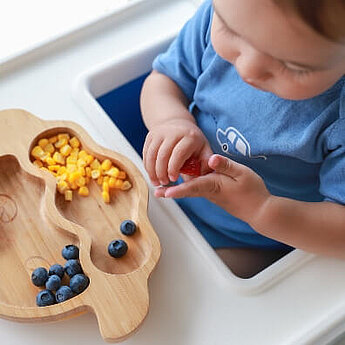Dealing with a fussy eating toddler
Written by Lucy Neary, Paediatric Dietitian, on 15.07.2024

Toddlers may be small but anyone who has parented one will tell you they have big emotions!
As your toddler discovers a growing independence, you might be starting to notice another change, too. Suddenly, your previously angelic little one is too ‘busy' to eat – or won't eat anything but breakfast cereal and toast fingers, no matter which meal it is. Any new foods are viewed with deep suspicion, and even foods they've always enjoyed might be suddenly rejected.
You'd be forgiven for wondering who's swapped your sweet baby and left this choosy child instead – but don't rush to panic stations straightaway. This sort of behaviour is perfectly normal, and it definitely isn’t your fault!
Why is my toddler being fussy with food?
Over the years I have lost count of the number of times a parent of a fussy eater has told me ‘when I started weaning, my baby ate anything I put in front of them’. It’s true, most babies are accepting of the foods you put down in front of them. But fast forward to toddlerhood and that picture can change quite dramatically. What once felt easy or fun can become stand offs and battles, ‘yucks’ and ‘nos’!
So what happens? Why do we go from parenting a happy accepting baby to a shouty avoidant toddler?
Growth slows: so this isn’t strictly a reason for fussy eating BUT it’s important to know that when babies reach a year old, growth slows. This leads to a decrease in appetite, so what can feel like fussy eating is often a child that simply doesn’t need as much food as they did before. They may eat their favourite part and leave the rest, leaving you feeling baffled.
Personality: if your child is highly emotional, cautious or strong willed they are more likely to have difficulties with eating. You are also more likely to lean towards offering their favourites to minimise the emotional outbursts.
Anxiety: whether it is generalised anxiety or solely related to food; the presence of anxiety may lead to decreased acceptance of foods.
Sensory issues: did you know we have eight senses? The five that most of us know about plus three that tell us how we feel inside our body and our space in time. Eating is an activity that uses all eight senses, so a child who has strong sensory preferences is more likely to also have stronger food preferences as well.
Normal development: the transition from baby to toddler brings about independence and curiosity and our human evolution has provided a reflex to prevent toddlers from eating foods they do not recognise. This kept us safe in the days when we could roam further away from our parents and risk eating poisonous berries or mushrooms. When you break a biscuit, your toddler no longer recognises it as the biscuit they wanted… cue feelings of danger and tantrum!
Life events: although the arrival of a new baby, moving to a new house or starting school may all feel like positive life events they all have the potential to impact eating. When there is a large change, children will often revert to safety which can lead to them dropping foods that may be more difficult for them.
Medical issues: previous reflux, food allergies, recurrent illness, neurodiversity and lots of others factors will affect how your child views foods and alters their eating habits. For example, with reflux; even if it is resolved your child will have memories stored of eating making them feel unwell which will stay with them for a long time.
How to encourage my toddler to eat?
The key to encouraging your toddler to eat, is really not to encourage! The research is very clear; the more you try to persuade a child to eat, the less they will do it.
Instead, try to think about creating the right environment for them to build their confidence with food enough to try it for themselves without you needing to intervene. Below you’ll find a few ‘do’s’ and ‘don’ts’ that might help when it comes to feeding your toddler; an important tip when working on fussy eating is not to try one thing then give up and move to another. Try to incorporate all of them consistently over time to increase the likelihood of seeing the results you want!
Do:
- Stick to a good routine. Aim for three meals a day and two snacks. Try not to offer food outside of these times as it’ll reduce their appetite at mealtimes.
- Stay relaxed and keep mealtimes a calm social space. Focus on the interactions you have instead of the food.
- Sit back and allow them to touch and play with the food while you eat something yourself. You can be a great role model for them to copy in their own time.
- Keep offering the foods they have refused – the more often you expose a toddler to a food, the more likely they are to accept it and eat it.
- Keep mealtimes regular and short – consistency is reassuring for children.
- Take action to reduce your worries so it’s easier to step back. Offer a good multivitamin and have weight and height plotted every few months.
Don't:
- Change everything to fit in with their food refusals - the more you do this, the more likely the problem will continue.
- Give up!
- Force them to eat – the more pressure you put on them, the less likely they are to eat. Withdraw the food without any fuss and try it again another time.
- Add foods to a ‘won’t eat’ list too soon – keep trying them.
- Prolong mealtimes in the hope this will make them eat.
- Offer more than around 400-500ml of milk.
- Hide foods or trick your toddler. Creating mistrust, especially with their favourite foods is likely to backfire and you may end up with an even smaller range of accepted foods.
As well as feeling frustrated that your toddler won’t eat the meal you have spent time preparing and that it will go in the bin, you’re probably worried that if they aren’t eating much, they won’t be getting the nutrients they need to grow properly. Try not to worry, this is often just a phase that toddlers go through. Use our tips above and be patient with your little one. You should also look at the foods that they eat across the week rather than each individual meal as this will give you a better overview. If you are really concerned about their, growth or eating habits, have a chat with your GP or healthcare professional.
How to introduce new foods to a fussy eater?
The introduction of new foods is often less about the food itself and more about how you offer them. If you have a table – use it! Sit and eat together as often as you can.
Put all the food in the middle of the table and let everyone serve themselves. This helps your toddler to feel included in the meal and reduces the anxiety of having foods they don’t like on their plate contaminating their accepted foods. Think about it in this way, if you went to a restaurant and your food came out with a slug on the plate, would you want to eat your meal?
Finally - don’t pressure! The more you try to get your toddler to eat something the more they will resist. In the short term, try to worry less about nutrition and focus on getting the environment right and the food will follow after.
When should I be concerned about my toddler’s picky eating?
For some children, their food refusal goes beyond what feels acceptable and it can be a real worry for parents. Whilst there’s no universal definition of the type of eating behaviours that need input from a professional, if your child fits with the statements below it might be worth speaking to your GP or a dietitian.
- Refuses whole food groups – such as no fruit or vegetables at all or no dairy foods.
- Their growth has slowed or stopped.
- They don’t seem able to chew and swallow a range of foods with confidence so stick to very soft, easy chew foods.
- Mealtimes feel impossible and emotions run high for your child or you whenever food needs to be eaten.
Tips to encourage fussy eaters to eat
One of the things I get asked a LOT is what are the best recipes for fussy eaters. I wish I could just write a picky eaters food list, but the reality is that it’s a very difficult question to answer because every child’s eating journey is slightly different and so are their preferences.
Some children love dry, crunchy beige foods. Whilst others want sweet or smooth foods.
Instead of trying to think of new recipes, try to ensure you are offering all of your child’s accepted foods across the week. Mix up when you offer foods and let go of food rules such as porridge is a breakfast food, and nuggets don’t go with rice. The more you can vary up your child’s diet within their safety zone the better.
Meet them in their space too to help them to feel included. For example, if your child leans towards bread create a family sharing board where everyone can make their own sandwiches with various fillings and maybe have some soup on the side for those who want it. Or if they like plain pasta, put a big bowl of plain pasta in the middle and a sauce with some cheese for the rest of the family.
I may sound like a broken record, but the more time you spend creating the right mealtime environment, getting into a good routine and allowing your child to find foods for themselves the better they will eat in the long run!
One day you’ll look back and wonder how they survived on so little. Until then – you’ve got this.



